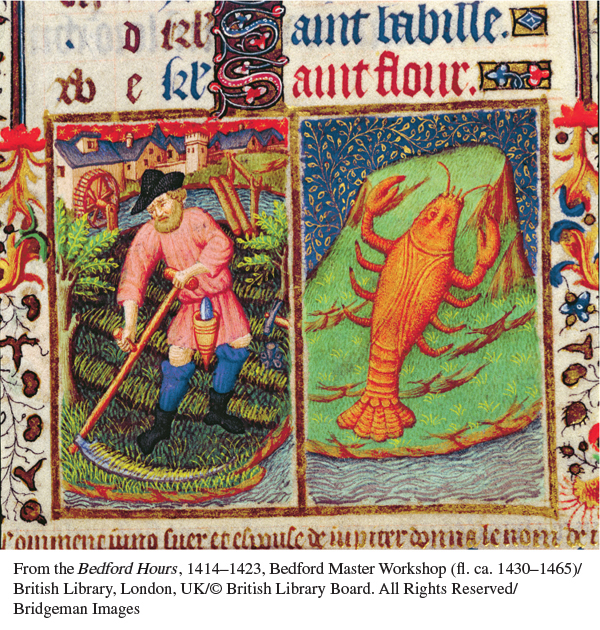A History of Western Society: Printed Page 287
A History of Western Society, Value Edition: Printed Page 274
A History of Western Society, Concise Edition: Printed Page 287
Work
The peasants’ work was typically divided according to gender. Men cleared new land, plowed, and cared for large animals; women cared for small animals, spun yarn, and prepared food. Both sexes planted and harvested, though often there were gender-
Once children were able to walk, they helped their parents in the hundreds of chores that had to be done. Small children collected eggs if the family had chickens or gathered twigs and sticks for firewood. As they grew older, children had more responsible tasks, such as weeding the family’s vegetable garden, milking the cows, and helping with the planting or harvesting.

In many parts of Europe, medieval farmers employed the open-
Meteorologists think that a slow but steady retreat of polar ice occurred between the ninth and eleventh centuries, and Europe experienced a significant warming trend from 1050 to 1300. The mild winters and dry summers that resulted helped increase agricultural output throughout Europe, particularly in the north.
The tenth and eleventh centuries also witnessed a number of agricultural improvements, especially in the development of mechanisms that replaced or aided human labor. Mills driven by wind and water power dramatically reduced the time and labor required to grind grain, crush seeds for oil, and carry out other tasks. This change had a significant impact on women’s productivity. In the ancient world, slaves had been responsible for grinding the grain for bread; as slavery was replaced by serfdom, grinding became women’s work. When water-
Another change, which came in the early twelfth century, was a significant increase in the production of iron. Much of this was used for weapons and armor, but it also filled a growing demand in agriculture. Iron was first used for plowshares (the part of the plow that cuts a deep furrow), and then for pitchforks, spades, and axes. Harrows — cultivating instruments with heavy teeth that broke up and smoothed the soil after plowing — began to have iron instead of wooden teeth, making them more effective and less likely to break. Peasants needed money to buy iron implements from village blacksmiths, and they increasingly also needed money to pay their obligations to their lords. To get the cash they needed, they sold whatever surplus they produced in nearby towns, transporting it there in wagons with iron parts.
In central and northern Europe, peasants made increasing use of heavy wheeled iron plows pulled by teams of oxen to break up the rich, clay-
By modern standards, medieval agricultural yields were very low, but there was striking improvement between the fifth and the thirteenth centuries. Increased output had a profound impact on society, improving Europeans’ health, commerce, industry, and general lifestyle. More food meant that fewer people suffered from hunger and malnourishment and that devastating famines were rarer. Higher yields brought more food for animals as well as people, and the amount of meat that people ate increased slightly. A better diet had an enormous impact on women’s lives in particular. More food meant increased body fat, which increased fertility, and more meat — which provided iron — meant that women were less anemic and less subject to disease. Some researchers believe that it was during the High Middle Ages that Western women began to outlive men. Improved opportunities also encouraged people to marry somewhat earlier, which meant larger families and further population growth.